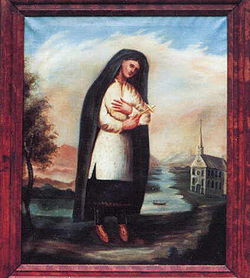A Step Closer to a Mohawk Saint
Linford D. Fisher
Amidst the hustle and bustle of this holiday season—and virtually guaranteed to be overlooked following the exodus of U.S. troops from Iraq and the death of Kim Jong II—a little extra Christmas spirit just emanated from Vatican City. Today Pope Benedict XVI certified the second miracle for Kateri Tekakwitha (1656-1680), the “Mohawk Saint” from Kahnawake on the banks of the Saint Lawrence River near Montreal. All that remains to complete her long journey to sainthood (which began with her beatification in 1980) is an official papal bull, which is likely to come next year.
Tekakwitha’s interesting story was brought to a wider audience by Allan Greer’s Mohawk Saint (2004)—a terrific book for undergrads, by the way. Having just used this volume in a course this fall (the class included a non-Native student who swears his mother’s name is…wait for it…Kateri Tekakwitha; he said his grandmother was enamored with her life), and having spent a large amount of the class discussion on the various appropriations of her by North American Native Catholics and the ongoing attempts towards her canonization, this news feels especially timely, even if it is not entirely surprising. Nonetheless, it is worthwhile to ponder how the effects of colonial-era evangelism continue to play out in the present, sometimes in surprising ways. As is often the case, the papal certifications and forthcoming bull only give “official” legitimacy to a following that is centuries old. Tekakwitha will not be the first Native from the Americas to be named a saint, but she is perhaps the most important one, at least for North American Native Catholics. As Greer and others have pointed out, Tekakwitha has long served as the unofficial patron saint for Native Catholics.
Read more here.
Amidst the hustle and bustle of this holiday season—and virtually guaranteed to be overlooked following the exodus of U.S. troops from Iraq and the death of Kim Jong II—a little extra Christmas spirit just emanated from Vatican City. Today Pope Benedict XVI certified the second miracle for Kateri Tekakwitha (1656-1680), the “Mohawk Saint” from Kahnawake on the banks of the Saint Lawrence River near Montreal. All that remains to complete her long journey to sainthood (which began with her beatification in 1980) is an official papal bull, which is likely to come next year.
Tekakwitha’s interesting story was brought to a wider audience by Allan Greer’s Mohawk Saint (2004)—a terrific book for undergrads, by the way. Having just used this volume in a course this fall (the class included a non-Native student who swears his mother’s name is…wait for it…Kateri Tekakwitha; he said his grandmother was enamored with her life), and having spent a large amount of the class discussion on the various appropriations of her by North American Native Catholics and the ongoing attempts towards her canonization, this news feels especially timely, even if it is not entirely surprising. Nonetheless, it is worthwhile to ponder how the effects of colonial-era evangelism continue to play out in the present, sometimes in surprising ways. As is often the case, the papal certifications and forthcoming bull only give “official” legitimacy to a following that is centuries old. Tekakwitha will not be the first Native from the Americas to be named a saint, but she is perhaps the most important one, at least for North American Native Catholics. As Greer and others have pointed out, Tekakwitha has long served as the unofficial patron saint for Native Catholics.
Read more here.


Comments